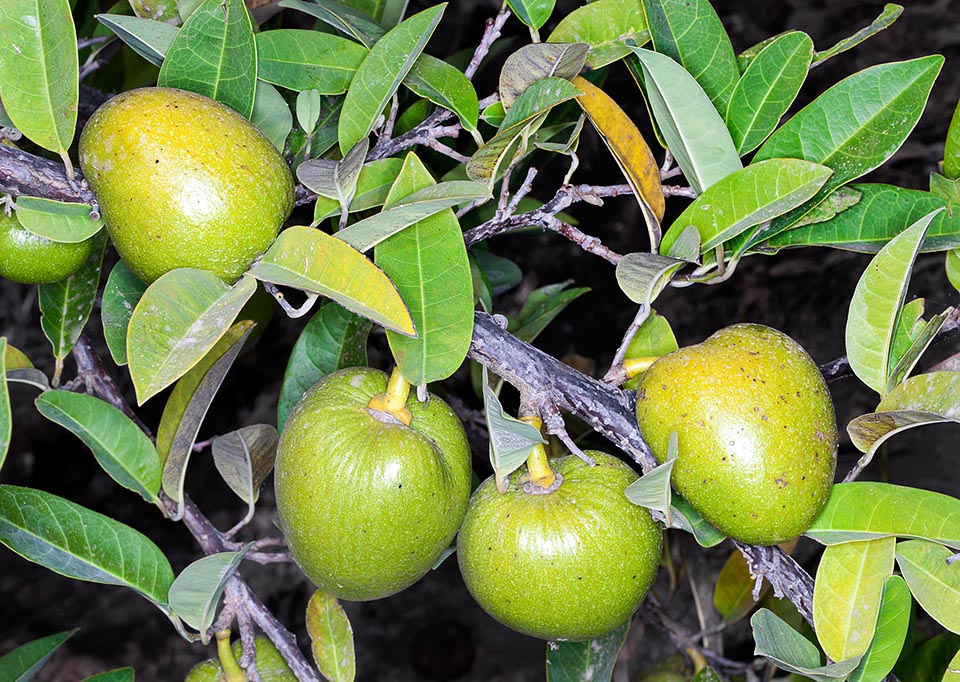Family : Annonaceae

Text © Pietro Puccio

English translation by Mario Beltramini
The species is native to tropical Africa (Cameroon, Gabon, Gambia, Guinea, Ivory Coast, Liberia, Nigeria, São Tomé and Principe, Senegal and Sierra Leone), North America (USA – Florida), Central America (Belize, Costa Rica, Guatemala, Honduras, Nicaragua and Panama), South America (Brazil, Colombia, Ecuador, French Guyana, Guyana, Surinam and Venezuela) and Caribbean (Antigua and Barbuda, Bahamas, Cuba, Dominica, Grenada, Guadeloupe, Hispaniola, Jamaica, Martinique, Montserrat, St. Lucia, and St. Vincent and Grenadines), where it lives on the banks of lakes, swamps and rivers and along the coasts and estuaries influenced by the tides with the roots which may survive immersed even for long periods.
The name of the genus comes, after some, from the Latin “annona” = nourishment, food, with reference to the alimentary use of the fruits, after others from the local name (in the Taíno language); the Latin name of the species “glabra” = glabrous, smooth, refers to the appearance of the surface of the fruit.
Common names: alligator apple, corkwood, cow apple, mangrove anona, monkey apple, pond apple (English); yuan hua fan li zhi (Chinese); anone des marais, cachiman cochon, corossol de la mer, corossolier des marais, guanamin, mamain (French); araticum-bravo, araticum-d’água, araticum-da-lagoa, araticum-do-bréjo, araticum-do-mangue, araticum do Rio, cortisso, maçã-de-cobra (Portuguese-Brazil); anona de Rio, anona lisa, anón de agua, anón de puerco, anón liso, bagá, cayuda, chirimoya cimarrona, chirimoya de los pantanos, corcho, palo bobo (Spanish); Alligatorapfel, Mangroven-Annone, Wasserapfel (German).
The Annona glabra L. (1753) is a shrub or a semi-deciduous tree up to about 12 m tall, even if usually it keeps lower, with grey wrinkly and slightly fissured bark and simple alternate leaves, on a 1-2 cm long petiole, ovate to elliptic with rounded or pointed apex, 5-16 cm long and 3-6 cm broad, rather coriaceous, of glossy intense green colour on the upper page, pale below, and prominent central nervation.

Native to tropical Africa, Annona glabra resists drought, floods and salt water. The raw fruits are insipid but due to its adaptability and fast growth is often used as rootstock for more prized Annona species that don't love humid soils. Various parts of the plant are used in the traditional medicine of the tropics © Giuseppe Mazza
The fruit is an ovoid syncarp (an aggregation of more simple fruits connate to form an apparently unique fruit) with rounded apex having smooth surface of yellow to orange colour with brown spots, 5-12 cm long and 5-8 cm broad, and astringent orange-pink pulp. The numerous (100-200) seeds are ellipsoid, laterally compressed of pale reddish brown colour about 1,5 cm long and 0,8 cm broad. It usually reproduces by seed, which germinates in 1-2 months, with the first flowering starting from the second year of age, and by cutting and air layering. The seed floats as well as the fruit, and maintains its ability to germinate for long time even in salted water; this fosters its dispersion thus rendering the species highly invasive in many tropical coastal areas.
Amply diffused species in the wild and naturalized in many humid tropical and subtropical areas, but little cultivated, its fruits, in spite of being edible, are rather tasteless and are rarely consumed fresh, they are at times utilized locally for preparing jams and an alcoholic beverage; its main employment is as rootstock for other species of Annona due to its adaptability to permanently humid soils. Fast growing, it requires full sun and can grow in soils periodically submerged by fresh as well as highly salted water, it does not resist to drought periods and to temperatures lower than 0 °C, which are therefore limiting factors to its diffusion.
Various parts of the plant are used in the traditional medicine; some studies have revealed a moderate antimicrobial, antifungal and insecticidal activity of the bark extracts and antitumoral activities of some compounds extracted from the seeds.
Synonyms: Annona palustris L. (1762); Annona laurifolia Dunal (1817); Annona peruviana Humb. & Bonpl. ex Dunal (1817); Annona uliginosa Kunth (1821); Annona australis A.St.-Hil. (1824); Annona chrysocarpa Lepr. ex Guill. & Perr. (1831); Asimina arborea Raf. (1840); Anona pisonis St. Hil. & Tul. (1842); Guanabanus palustris M. Gómez (1897); Annona klainei Pierre ex Engl. & Diels (1901).
→ To appreciate the biodiversity within ANNONACEAE family and find other species, please click here.
